Table of Contents
🌍 DFDI in Education and Healthcare Sectors: A Path to Equitable Digital Transformation
DFDI in education and healthcare sectors is shaping a new era of inclusive, tech-driven development. Digital Foreign Direct Investment (DFDI) goes beyond infrastructure—it enables underfunded sectors to leap into the digital future through global capital, innovation, and strategic partnerships.
In many developing countries, education and healthcare face persistent challenges: understaffed systems, lack of access, and outdated tools. Through DFDI, these gaps are being addressed with smart classrooms, virtual learning platforms, telemedicine, mobile health apps, and digitized systems that deliver services at scale.
This article explores the multifaceted role of DFDI in education and healthcare sectors, its benefits, infrastructure components, success stories, and how to maximize its potential.
🎓 Why DFDI in Education and Healthcare Sectors Matters
Both sectors are essential to human capital development. However, public budgets in developing regions often fall short. That’s where DFDI in education and healthcare sectors becomes transformative.
📌 Key Benefits:
- Expands access to underserved populations
- Modernizes outdated systems with scalable solutions
- Bridges the urban-rural divide
- Introduces global best practices and technologies
- Drives long-term economic and social resilience

🏫 DFDI in Education: Smart Learning for All
One of the most transformative impacts of DFDI in education and healthcare sectors is its ability to create smart learning environments that bridge the gap between quality education and accessibility. In developing countries where schools are overcrowded, underfunded, and often lack qualified teachers or up-to-date learning materials, Digital Foreign Direct Investment (DFDI) is introducing cutting-edge technologies that democratize access to knowledge.
Smart learning doesn’t just mean putting computers in classrooms. It’s a holistic approach that combines infrastructure, content, training, and analytics—allowing learners to thrive regardless of geography, income, or ability.
🧠 Key Components of DFDI-Powered Smart Education
To fully understand the role of DFDI in education and healthcare sectors, we need to look at the core features of smart learning initiatives that are backed by international digital investments:
1. Digital Classrooms and Virtual Schools
DFDI enables the deployment of technology-enhanced classrooms equipped with:
- Interactive smartboards
- Wi-Fi connectivity
- Projectors and audio-visual learning tools
- Cloud-based access to course material
In areas where building new schools isn’t viable, DFDI supports virtual school platforms that allow students to learn from home using smartphones or community kiosks.
2. Learning Management Systems (LMS)
These platforms provide:
- Digital curriculum aligned with national standards
- Quizzes, assessments, and grading tools
- Real-time performance analytics
- Teacher dashboards for managing students’ progress
LMS platforms funded by DFDI are increasingly being localized to support regional languages and cultural relevance, expanding their effectiveness in diverse contexts.
📱 Mobile Learning for Underserved Communities
With high mobile penetration even in low-income countries, DFDI in education and healthcare sectors is funding mobile-first learning solutions. These include:
- Offline-capable learning apps
- SMS-based learning modules
- Audio-visual lessons for areas with low literacy
- AI-powered chatbots for tutoring and guidance
Example: In India, a DFDI partnership launched a mobile app offering video tutorials and interactive tests for students preparing for board exams. Within 6 months, over 2 million students in rural areas were actively using it.
🧑🏫 Digital Training for Teachers
A smart classroom is only as effective as its educator. DFDI projects also focus on upskilling teachers through:
- Online teacher training modules
- Certification courses in digital pedagogy
- Peer-to-peer support groups
- Training-of-trainer (ToT) models to create local tech champions
Impact: In Ghana, DFDI-supported teacher training led to a 40% increase in digital tool usage in public schools within the first academic year.
🌍 Inclusive Education for All
DFDI in education and healthcare sectors also promotes inclusivity by targeting historically underserved groups:
- Girls and women, by providing online learning that respects cultural restrictions
- Students with disabilities, through assistive technologies and adaptive content
- Minority and remote communities, with multilingual content and community facilitators
- Adult learners, via mobile-based microlearning for vocational training and financial literacy
Case Study: In Pakistan, DFDI-backed online platforms offered vocational e-learning for women in tribal areas, enabling many to start microbusinesses after completing certification courses.
🏫 Building Resilient Education Systems
Post-COVID, the emphasis of DFDI in education and healthcare sectors has shifted toward resilience. Governments and donors are investing in:
- Hybrid learning models (online + offline)
- Cloud-based curriculum backups
- Smart attendance systems
- Real-time emergency communication apps for school safety
These innovations not only prevent learning loss during crises but also create flexible systems that can evolve with future needs.
📊 Data-Driven Decision Making
Modern DFDI education projects integrate data analytics to guide policymaking and classroom strategies:
- Student progress dashboards
- Dropout and absenteeism prediction models
- Heatmaps of tech utilization by school
- Real-time alerts on infrastructure issues
With better data, ministries and local administrations can make informed decisions to scale what works.
📚 Case Study: Rwanda’s Digital Learning Expansion
Rwanda has become a regional leader in education innovation due to sustained DFDI support:
- Over 4,000 schools have digital classrooms
- National curriculum digitized and distributed via cloud LMS
- Teachers receive quarterly training on emerging EdTech
- 250+ rural e-learning centers built using solar power
Result: Literacy rates rose by 20%, and dropout rates decreased significantly in digital-supported schools.
🛠️ The Role of Public-Private Partnerships
DFDI works best when governments, NGOs, and private investors collaborate to:
- Set national digital learning goals
- Establish policy and regulatory clarity
- Co-fund infrastructure and device programs
- Ensure alignment with global education standards
These partnerships make it easier to replicate and scale successful initiatives.
🌐 Looking Ahead: Future Trends in DFDI Education Projects
5G-enabled immersive experiencesquitable access to education, aligning with SDG 4 (Quality Education for All).
AI tutors for personalized learning
AR/VR simulations for science and technical training
Blockchain credentials for secure, verifiable student records
Gamification to improve student engagement
🏥 DFDI in Healthcare: Smarter, Stronger Health Systems
🩺 Telemedicine and Virtual Care
A crucial benefit of DFDI in education and healthcare sectors is enabling telemedicine, especially where hospitals are distant or under-equipped.
DFDI supports:
- Virtual doctor consultations
- Remote diagnostics and treatment plans
- Health kiosks in villages with live chat support
- Mobile apps for chronic condition monitoring
Example: In Rwanda, a DFDI-funded platform facilitated 1 million virtual consultations in rural zones—reducing unnecessary travel and improving diagnosis speed.
🏥 Hospital Digitization and e-Health Systems
Hospitals and clinics are being digitized with DFDI investment:
- Electronic Health Records (EHR)
- Smart diagnostic equipment
- AI-powered triage and patient flow systems
- Secure data sharing between facilities
✅ Outcome: Faster treatment, fewer errors, and better resource use.
🚑 Mobile Health and Emergency Response
Mobile health (mHealth) platforms offer community-level solutions:
- SMS-based prenatal care reminders
- Mobile vaccination tracking
- Emergency hotlines and ambulance GPS systems
- Mental health chatbot services in local languages
Result: Improved maternal-child health outcomes and responsive emergency care—even in remote areas.
⚖️ Comparing Impact: Education vs. Healthcare
| Category | Education | Healthcare |
|---|---|---|
| Reach | Schools, students, teachers | Clinics, hospitals, rural patients |
| Tools | LMS, smartboards, digital libraries | EHR, telehealth, AI diagnostics |
| KPIs | Literacy rates, test scores, enrollments | Reduced mortality, shorter wait times |
| Barriers | Teacher tech skills, device access | Network reliability, data privacy |
| Equity Focus | Girls, disabled students, rural areas | Mothers, children, chronic illness patients |
🧱 Infrastructure Essentials for DFDI Success
To make the most of DFDI in education and healthcare sectors, several infrastructure elements are key:
📡 Connectivity
- 4G/5G towers, satellite Wi-Fi
- Broadband for schools and clinics
🔋 Energy Access
- Solar-powered digital health stations
- UPS backup for school servers
🖥️ Devices
- Tablets for students and health workers
- Diagnostic tools and laptops for administrators
☁️ Cloud Platforms
- Data centers for secure storage
- Apps for real-time communication and analysis
🌍 Global Case Studies: DFDI in Action
📘 India: EdTech in Low-Income Schools
A partnership with global investors funded smart learning kits in 50,000 government schools. Result: 3.2 million students gained access to e-learning content in local languages.
🏥 Kenya: HealthTech in Remote Clinics
DFDI enabled 800+ rural clinics with electronic medical systems and virtual care platforms—boosting maternal care registration by 65%.
🌐 Colombia: Dual-Sector Digital Zones
DFDI funds were used to build “Digital Development Zones” where both education and healthcare platforms co-exist. Clinics double as learning centers.
🔮 Future of DFDI in Education and Healthcare Sectors
Expect to see:
- AI tutors and diagnostic bots
- Virtual and augmented reality in training
- Personalized learning and health plans
- Integration of blockchain for credential and record security
- Mobile-first services for ultra-remote populations
DFDI is evolving from “access to technology” to “equity through innovation.”
🧩 Challenges to Overcome
Despite the promise, DFDI in education and healthcare sectors faces hurdles:
- Lack of digital literacy
- Cybersecurity concerns
- Inconsistent policy frameworks
- High device and bandwidth costs
- Low maintenance and follow-up in rural zones
✅ Solutions: Public-private partnerships, local co-creation, long-term MoUs, and scalable models.

❓ FAQs – DFDI in Education and Healthcare Sectors
1. What does DFDI stand for?
DFDI stands for Digital Foreign Direct Investment—foreign capital used to build digital systems in key sectors like education and healthcare.
2. How does DFDI improve education?
It provides smart classrooms, online learning tools, and teacher training that enhance access and quality.
3. What healthcare benefits does DFDI enable?
Telemedicine, e-health records, mobile diagnostics, and AI-powered triage services, especially in underserved areas.
4. Can DFDI projects be sustainable long-term?
Yes—with local ownership, scalable tech, inclusive design, and strategic partnerships, DFDI can yield long-lasting benefits.
5. Who can initiate DFDI-based projects?
Governments, NGOs, private investors, and international development agencies.
Follow us on Facebook for Quick Response & Quires – Digital Foreign Direct Investment (DFDI)
